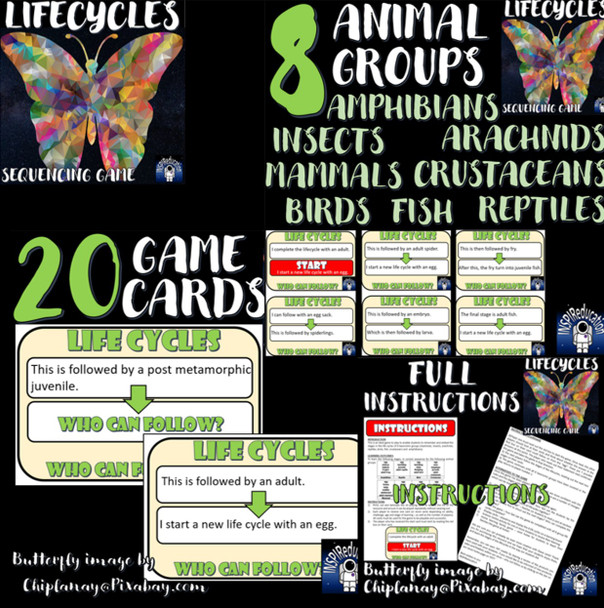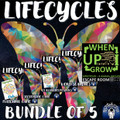Description
This bundle of our 5 Life Cycle products includes all you need to engage your students in the vocabulary and the sequencing of the stages in the life cycles of 8 different taxonomic groups:
- Insects
- Arachnids
- Mammals
- Birds
- Fish
- Crustaceans
- Amphibians
- Reptiles
The bundle includes:
- Escape Room: "When I grow up"
- 8 Life Cycle posters (color and black and white sets)
- 3 Levelled wordsearches to encourage spelling and vocabulary knowledge
- Matching game - linking vocabulary to taxonomic groups and observing similarities and differences between each within life cycles
- "I have... Who has?" Sequencing card game for up to 20 players
Escape Room: "When I grow up"
Using an Escape Room to develop curriculum knowledge is an exciting activity that will inspire learners from 2nd Grade to 5th Grade.
The curriculum content of this Escape Room is linked to Science, and in particular:
- Lifecycles of animals
- The vocabulary of lifecycles
- Sequencing the growth stages in different lifecycles of a range of animals
The aim of the Escape Room is to provide jeopardy for the children to work under pressure to solve 10 challenges to help raise their knowledge of Lifecycles. The 10 Challenges within this Escape Room will support knowledge and understanding of lifecycles, the sequences, similarities, differences and the vocabulary used within them.
Included within this Escape Room:
- Pupil Answer Book (Code Key Booklet)
- Answer Booklet for teachers
- Starting script to set the scene of the Escape Room and explain what the students must do
- Concluding script, celebrating the learning which has taken place and allows the students to “leave” the Escape Room
- Table labels for students to name their own teams
- Full instructions to be able to simply print and go within your own classroom
Before beginning, you will need to prepare the following:
- A copy of the Pupil Workbook for each group
- A set of table team names for every group – prepared beforehand and given to each group to set up their own working space
- IT sources and research materials (if students are new to this topic area)
- Initial Starting Script sharing the problem to the children
- Completion Script celebrating the completion of the challenge
Children do not need prior knowledge of Lifecycles to complete this Escape Room so is suitable for a starter challenge to a new topic. The ability to have access to research resources will support the answers. This Escape Room is ideal as a review of learning to identify what the children have learnt and retained as a result of completing the study unit of Lifecycles.
The activity begins by the teacher reader the Initial Message received. It clearly tells the children that they are required to help raise their understanding of lifecycles in order to solve 10 challenges in order to escape the room. The accurate completion of each of the challenges enables the students to move from one challenge to another. They must complete each challenge correctly before moving onto the next challenge, continuing the Escape Room completing all 10!
After the 10th activity – the teacher can read the final script which reviews the learning the children have undertaken as they have completed each of the challenges. This script, together with team labels and the opening challenge script are contained within the Resource Pack.
Each activity focuses and builds the children’s knowledge of Lifecycles
The 10 activities are based on the following outcomes:
- Word Search to introduce 40 key words related to Lifecycles ensuring that children develop a wide vocabulary. There is also an extra hidden word which the children must find in order to solve the Code Key and move to the next challenge.
- Linking vocabulary which animals share in common with one another or are specific to their own taxonomic group.
- Lifecycles of fish
- Lifecycles of arachnids
- Lifecycles of amphibians
- Lifecycles of reptiles
- Lifecycles of crustaceans
- Lifecycles of birds
- Lifecycles of mammals
- Lifecycles of insects
When all 10 activities are completed, and the children have gained the correct Code Keys from each activity, the final celebratory script can be read which reviews the learning and informs the children that they have been successful and can leave the Escape Room!
8 Life Cycle Posters
This product includes 8 A4 color posters (and a set of black and white posters also) which can be printed and displayed in homes and classrooms to support students acquire the language and knowledge associated with Life cycles in animals.
Animal groups within the product include:
- Insects
- Amphibians
- Crustaceans
- Birds
- Fish
- Mammals
- Reptiles
- Arachnids
These bright and colorful posters - including bright images to accompany each poster will really light up the learning area and support the development of both language and sequencing of life cycles of the 8 animal groups.
Three Wordsearches of varying complexity
This set of three wordsearches aim to teach students the key vocabulary of lifecycles within the 8 most common taxonomic groups: Insects, mammals, fish, arachnids, reptiles, birds, amphibian and crustacean.
Each group has its’ own set of vocabulary, listed in order of lifecycle, from egg through to mature animal. The three wordsearches get progressively more complex, supporting students to not only learn the vocabulary associated with each group, but also the cycle of each animal group with growing independence.
- Wordsearch 1: Find the 40 words and tick off each word from the 8 lists provided (one for each taxonomic group)
- Wordsearch 2: Same wordsearch as (1) but this time, the vocabulary to find has been removed, with only the first letter and lines given to represent the number of letters needed. This embeds the learning from the first wordsearch.
- Wordsearch 3: Completely new wordsearch, with the same 40 words to find, without the given words – just initial letter and lines to identify how many letters the word contains.
Instructions:
- Decide on the level you wish to start your students on (see above for the complexity of each of the word search levels).
- Level 1: Students to find 40 words hidden in the wordsearch. Each of the words are listed within each of the 8 taxonomic groups – therefore, the students will have to find 8 eggs – one for each of the taxonomic groups included. When they have found all of the words – they have completed the wordsearch. An answer key is included for ease of assessment.
- Level 2: As with level 1, the students will use the same wordsearch to embed the vocabulary of life cycles within the 8 categories. However, this time, the activity is more complex as the words which the students need to find have been removed. Instead, they only have access to the initial letter and a number of lines, signifying the number of letters within the word. This encourages the students to learn and sequence the vocabulary linked to each of the 8 lifecycles for the different taxonomic groups.
- Level 3: As with level 2 – but with a different wordsearch: The students must identify the 40 key words for each of the life cycles and then find them within the wordsearch. At this point, the students will have learnt the stages and the vocabulary associated with life cycles in insects, mammals, fish, arachnids, reptiles, birds, amphibian and crustacean.
This product contains three wordsearches and two answer keys.
Matching Game
This product encourages students to match word cards to the sequence stages within the life cycles of 8 different animal groups:
- Insects
- Arachnids
- Crustaceans
- Mammals
- Birds
- Fish
- Amphibians
- Reptiles
Preparation is easy - once downloaded, the resource should be printed off and then laminate all 16 pages. This will ensure that the resource lasts for a longer period of time and can be used by many students - with the ability of also being wiped clean. Once laminated, cut out the word cards and answer keys for each of the 8 animal cards. You may want to keep the answer keys separate from the game cards!
The aim of the product is to match the words to the lifecycle stages of the animals included within the pack. There are many ways that this resource can be used to do that. These are some of the ways in which we have developed the game within our classrooms:
- Place all word cards face down and the 8 game cards facing up. Taking in turns, students reveal a word card and work out where the card can be placed. A point is awarded for each correctly placed word laid onto the game cards.
- Place all word cards up – speed challenge – how quickly can each student correctly name all 8 life cycles?
- Science Center – as above with one student working on the activity.
- Home learning – send home with a student who teaches the game to someone at home.
- Looking for similarities and differences – once completed – how many similarities can the students find between the 8 animal groups?
There are lots of opportunities for learning with these matching cards – students even invent their own! We hope that they enjoy using and learning from them as much as our students did.






















